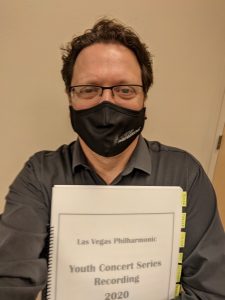
By Donato Cabrera│medium.com/@donatocabrera
November 1, 2020
This past week saw the Las Vegas Philharmonic come together for the first time since March to make music. We gathered in a large television studio at Vegas PBS and recorded one of our very effective youth concert programs that I helped create for the San Francisco Symphony and refined for the Las Vegas Philharmonic.
Out of the ashes and rubble of the great San Francisco earthquake of 1906, the San Francisco Symphony emerged. It’s first concert in 1911 wasn’t a star-studded gala, but a concert held for the workers and artisans who were still rebuilding the city, and it’s second concert was a family concert. It should not go unnoticed that the first project the Las Vegas Philharmonic chose to undertake since the lockdown began was an educational concert, to be made available for classrooms and streaming in the near future. Las Vegans should be proud that there finally resides within its borders an honest to goodness arts institution.
We also decided to refine and retool the programming to reflect the diversity in music that should be celebrated in our repertoire, especially for an educational concert! Rather than play the wonderful yet ubiquitous Fanfare for the Common Man by Aaron Copland, we recorded Joan Tower’s fantastic, Fanfare for the Uncommon Woman.
Copland’s Hoedown is raucously fun, but so is the first movement of Peggy Stuart Coolidge’s Pioneer Dances.
And our wonderful concertmaster could’ve easily performed a movement from a concerto of a variety of classical composers, from Mozart to Beethoven, but we chose to record a movement of one of the many brilliant violin concertos composed by Joseph Bologne, the Chevalier de Saint-Georges.
Arts institutions, including symphony orchestras, are given the task of not following the public’s tastes and desires for art, but leading the public’s tastes and desires for art. Without doubt, the current dilemma arts institutions now face is dire, but time and again I read in local and national press articles of visionless arts leaders making hapless and helpless statements, or in the case of most music directors, saying nothing at all. Now is the time for local arts leaders to stand up and fight for local art to be made, danced, sung, and performed!
